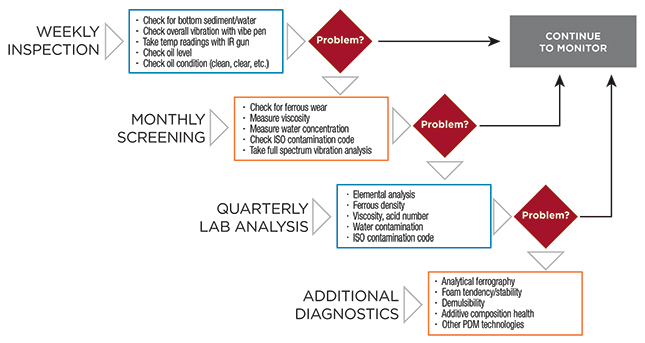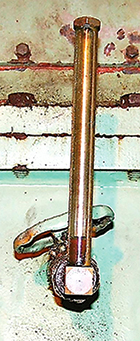Oil analysis is the cornerstone of effective condition-based maintenance programs. Commercial oil analysis labs play a significant role in developing these programs and can help process facilities move from maintenance programs based on responding to failures to programs based on the condition of equipment and lubricant.
During a coaching session on reliability and lubrication, one plant’s maintenance personnel discussed laboratory oil analysis frequency. Like many facilities, this plant preferred to conduct their lab analyses on a quarterly basis. Although quarterly analysis is effective, waiting months to analyze lubrication poses risks for the plant. A successful oil analysis and lubrication program requires a more proactive approach that includes frequent inspections, solid maintenance training and proper monitoring accessories.
Integrated Oil Analysis
Integrating an oil analysis program is the key to early detection. However, plants often rely too heavily on analysis from outside labs. Truly effective oil analysis programs include integrated inspections and on-site screening.
Equipment can suffer from several possible lubrication failures during operation. If the root causes of those failures are not addressed, the maintenance problem can quickly go from bad to worse. Ninety days is a long time to go without feedback on equipment or lubricant condition.
 Figure 1. An integrated oil analysis approach (Images and graphics courtesy of Des-Case Corporation). Click to enlarge.
Figure 1. An integrated oil analysis approach (Images and graphics courtesy of Des-Case Corporation). Click to enlarge.Integrated oil analysis programs require daily or weekly inspections and monthly screenings, which occur in the time between quarterly lab analyses. An effective program will also include exception testing or diagnostics that may result from the lab analyses.
The daily or weekly inspection is perhaps the most effective front-line defense against equipment failures from improper or inadequate lubrication. These inspections can identify problems earlier than the quarterly analysis, such as sedimentation, water infiltration, excessive vibration, high running temperature, incorrect oil level and a change in the oil condition.
Monthly screening provides a closer look at the equipment’s condition. Personnel can identify changes in viscosity and wear debris, as well as problems with water concentration and solid contamination. Field instruments are often required to complete this level of screening and provide the necessary feedback to assess the overall condition of the machine and lubricant.
However, monthly screening does not replace quarterly lab analysis. The lab provides a controlled environment with standard testing methods to produce consistent feedback. A problem found during a monthly screening should result in further investigation by the lab.
Additional diagnostics may be required if targets or alarms are exceeded. If a problem is identified during the integrated oil analysis program, the equipment should undergo the next level of inspections immediately. If done correctly, visual inspections can identify the first signs of equipment failure and danger.
Inspection Check Sheets
Inspectors are responsible for knowing what to look for during visual inspections. Check sheets should be highly detailed to ensure the inspection is done properly. Phrases such as “inspect machine” or “record machine condition” are not specific enough to guarantee equipment condition or safety.
Inspection check sheets should define individual tasks and include enough details to inform inspectors whether or not they should move to the next level of screening. When inspecting for water in oil, for example, inspectors must follow each step of the process and record details for an accurate reading.
Water co-exists in oil in three ways: free, emulsified and dissolved. In most cases, free water seeks out the lowest point in a reservoir. Free water is also fairly easy to spot because it resides separately from the lubricant.
The check sheet should include the following instructions:
- Inspect the oil sight glass for any sign of free water.
- If free water is visible, record the approximate amount of free water relative to the oil sight glass.
- Compare the amount of free water to the last inspection report.
- If the rate of increase of the amount of free water is abnormal, look for potential sources of ingress.
 Image 1. A typical oil level gauge may not provide all the necessary information to direct maintenance activities.
Image 1. A typical oil level gauge may not provide all the necessary information to direct maintenance activities.Approximating the rate of change from one inspection to another plays an important role in determining when a condition is normal or abnormal. Many systems have recurring maintenance risks, such as visible free water, high operating temperatures or dark oil color. Understanding the difference from one inspection to the next will help determine whether to move to the next level of analysis or continue monitoring.
Monitoring Accessories
Visual inspections should be objective, easy to complete and efficient. To that end, inspectors should consider using equipment that ensures consistent and repeatable data. Standard level gauges and sight glasses are common to some equipment components, but most do not address the need for objective measurement standards.
For example, a standard liquid level gauge may not always show an accurate oil level at first glance (see Image 1).
By simply looking at the level gauge, inspectors should be able to tell if the oil in the sump is within the allowable minimum-to-maximum range. Intuitively, an inspector might believe the oil level is low based on the level indicated in the sight relative to the length of the level gauge. However, this level is often supplied by the equipment owner as opposed to the original equipment manufacturer. The liquid level gauge may be longer than required, or it may have been installed in a port intended for an oil level plug or sight glass. A liquid level gauge requires that a minimum and maximum oil level be clearly marked.
A sophisticated lubrication program will use tools and accessories developed for first-line analysis. Three-dimensional accessories provide clear feedback of inspection data, such as bottom sediment and water, oil level and oil color.
Creating Value
The goal of an integrated oil analysis model is to add as much value to a facility’s lubrication program as possible. However, no system is error-proof. Even with the right people and tools for the job, mistakes will happen.
For that reason, facilities must focus on creating an environment that encourages system and employee accountability.
An operation adds value when personnel build a program around an organized, efficient system. Creating value in a lubrication program is an important catalyst to value-creation in all areas of a plant’s maintenance and reliability program.
A well-designed and executed lubrication program eases the demand for reactive maintenance as the focus shifts to a more proactive approach.


